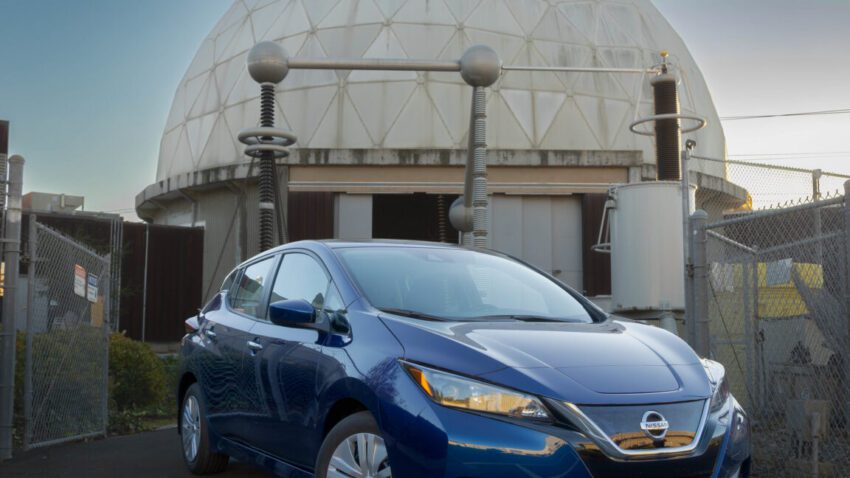
how two nissan leafs help make a California’s Redwood Coast Airport is pioneering a new approach to energy resilience by integrating bidirectional electric vehicle (EV) charging into its microgrid, utilizing two Nissan Leaf vehicles.
how two nissan leafs help make a
Overview of the Redwood Coast Airport Microgrid
Located in Humboldt County, California, the Redwood Coast Airport has been at the forefront of sustainable energy solutions since the implementation of its microgrid in 2021. This microgrid is designed to enhance the airport’s energy independence and resilience, particularly in the face of increasing climate-related disruptions and power outages. The microgrid is powered by a 2.2 MW solar array, which generates renewable energy, and is supported by 8.9 MWh of battery storage. Additionally, a 300 kW net-metered solar system allows the airport to feed excess energy back into the Pacific Gas and Electric (PG&E) local grid.
Key Features of the Microgrid
- Solar Array: The 2.2 MW solar array is a significant contributor to the airport’s energy supply, harnessing sunlight to produce clean energy.
- Battery Storage: With 8.9 MWh of battery capacity, the microgrid can store energy generated during sunny periods for use during times of high demand or outages.
- Bidirectional Charging: The integration of bidirectional charging technology allows the Nissan Leaf vehicles to not only draw power from the grid but also supply energy back to the airport’s microgrid when needed.
The Role of Electric Vehicles in Energy Resilience
Electric vehicles, particularly those equipped with bidirectional charging capabilities, are becoming increasingly important in the quest for energy resilience. The Nissan Leaf, a popular EV model, is at the center of this innovative approach at the Redwood Coast Airport. By utilizing these vehicles as mobile energy storage units, the airport can enhance its operational capabilities during emergencies.
Bidirectional Charging Explained
Bidirectional charging technology allows electric vehicles to both receive and supply electricity. This means that when the Nissan Leaf is fully charged, it can discharge energy back into the microgrid, providing additional power during peak demand or outages. This capability is particularly valuable for facilities like airports, which require a constant and reliable energy supply.
Benefits of Bidirectional Charging
- Energy Independence: By utilizing EVs as part of the microgrid, the airport can reduce its reliance on external power sources, making it more self-sufficient.
- Cost Savings: The ability to store and utilize solar energy can lead to significant cost savings on energy bills, as the airport can draw from its own generated power rather than relying solely on the grid.
- Environmental Impact: The use of renewable energy and electric vehicles contributes to a reduction in greenhouse gas emissions, aligning with California’s ambitious climate goals.
Operational Implications for the Airport
The integration of bidirectional charging and the microgrid has several operational implications for the Redwood Coast Airport. In addition to enhancing energy resilience, these technologies can improve the airport’s overall efficiency and sustainability.
Emergency Preparedness
One of the primary advantages of the microgrid is its ability to maintain operations during power outages. In the event of a grid failure, the microgrid can continue to supply power to critical airport functions, such as lighting, communication systems, and essential services. This capability is particularly crucial for ensuring safety and security in emergency situations.
Operational Efficiency
By harnessing solar energy and utilizing battery storage, the airport can optimize its energy consumption. During periods of low demand, excess solar energy can be stored for later use, reducing the need to draw power from the grid. This not only lowers operational costs but also minimizes the airport’s environmental footprint.
Community Engagement and Education
The Redwood Coast Airport’s innovative approach to energy resilience serves as a model for other airports and communities. By showcasing the benefits of renewable energy and electric vehicles, the airport can engage with local stakeholders and educate the public about sustainable practices. This engagement can foster a greater understanding of the importance of energy resilience and climate action.
Stakeholder Reactions and Future Implications
The integration of bidirectional charging and microgrid technology at the Redwood Coast Airport has garnered attention from various stakeholders, including local government officials, environmental advocates, and the aviation community. Many view this initiative as a significant step toward a more sustainable future for airports and other critical infrastructure.
Local Government Support
Local government officials have expressed support for the airport’s efforts to enhance energy resilience. The project aligns with California’s broader goals of reducing greenhouse gas emissions and promoting renewable energy. By investing in sustainable technologies, the Redwood Coast Airport is positioning itself as a leader in the aviation sector.
Environmental Advocacy
Environmental advocates have praised the airport’s commitment to sustainability. The use of electric vehicles and renewable energy sources contributes to a reduction in air pollution and greenhouse gas emissions. This initiative aligns with California’s ambitious climate goals and serves as a model for other airports seeking to adopt similar practices.
Future of Airports and Energy Resilience
The success of the Redwood Coast Airport’s microgrid and bidirectional charging integration could pave the way for similar initiatives at airports across the country. As climate change continues to pose challenges to infrastructure and energy systems, airports must adapt to ensure their resilience. The lessons learned from this project can inform future investments in sustainable technologies and energy solutions.
Conclusion
The Redwood Coast Airport’s integration of bidirectional charging and microgrid technology represents a significant advancement in energy resilience for aviation infrastructure. By leveraging renewable energy sources and electric vehicles, the airport is not only enhancing its operational capabilities but also contributing to a more sustainable future. As other airports look to adapt to the challenges posed by climate change, the Redwood Coast Airport serves as a beacon of innovation and progress in the pursuit of energy independence and environmental stewardship.
Source: Original report
Was this helpful?
Last Modified: November 15, 2025 at 3:37 am
2 views















